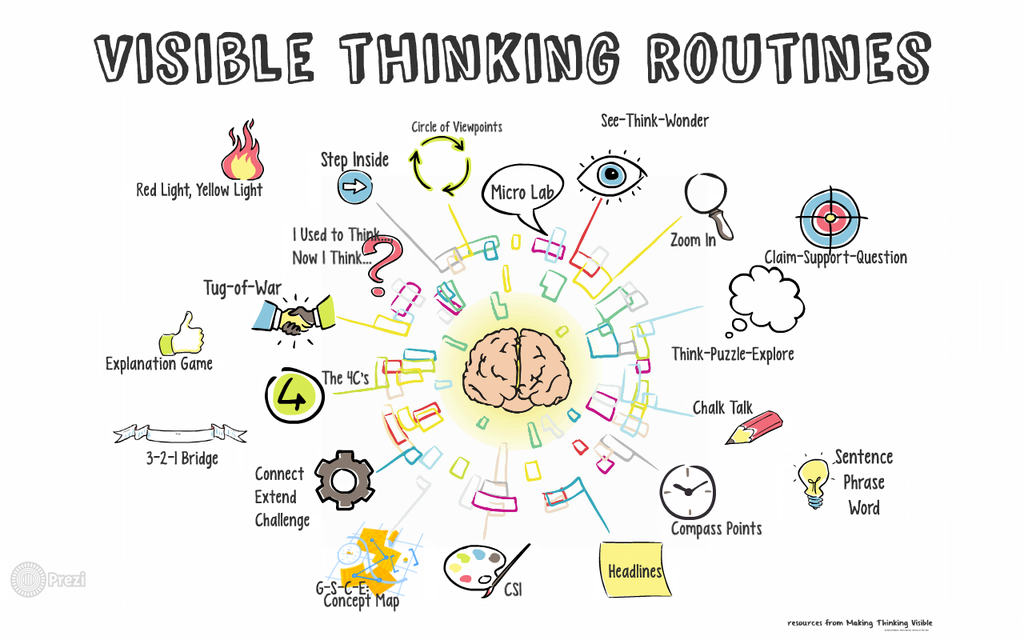
“Do the reading by Friday. We’re going to talk about it in class, so be prepared.”
I don’t know about you, but this was a sentence that was frequently said in my high school science courses. Of course I did the reading, but come Friday, I had nothing to say about it, and neither did any of my classmates. When our teacher asked us to make some comment about the 25 pages we read from the textbook about endothermic and exothermic reactions, we weren’t even able to make something up. There were multiple reasons we didn’t have anything to say:
- We weren’t at all engaged with the text
- We didn’t understand what we were reading
- We weren’t thinking, nor did we know how to begin to think about what we were reading

However, if my science teachers had used strategies that make thinking visible, I may have had a completely different experience in high school science.
Why Use MTV Strategies?
There are many reasons that MTV strategies should be used in the classroom. For starters, it is a way to engage students, vary classroom routines, and allow even the most quiet students to express their thoughts. However, one of the most important reasons to use MTV strategies is to get students to learn how to think.

Sounds kind of silly, I know, but in our schooling system students often don’t learn how to think. They don’t learn how to make connections, ask questions, look for bias, or interact with text and media in a meaningful way. By using strategies that make thinking visible, we are giving students strategies that allow them to practice these meaningful interactions in hopes of developing more critical thinkers and learners.
In this Ted Talk, Jesse Richardson gives his own opinion about what it means to teach students how to think rather than what to think.
Let’s explore some MTV strategies that you can implement in your own classroom.

1.) The Explanation Game
- This activity requires students to look at something (an object or a concept) closely, observe all of the parts of what they are looking at, and try to form explanations about how all of those parts work together to make a certain thing or perform a certain function.
- After making observations about what they noticed from each part and generating potential explanations about how the parts are connected, students must support their claims with evidence and reasoning. This is also a great place where a student’s background knowledge can be acknowledged and utilized.
- Ask the students if they can think of any alternate explanations, that way students are actually taking the time to think about all of the possibilities and not jumping to conclusions.

2.) Headlines
- Students practice identifying main events or key concepts, synthesizing, and summarizing the most important pieces of information.
- Ask students to write a headline for a concept, text, or scientific social issue that identifies the main concepts and key information that students believe are the most important to remember.

3.) Circle of Viewpoints
- The purpose of this activity is to get students to consider a variety of different perspectives concerning a specific topic or issue.
- After generating a list of of different viewpoints as a class, students will choose a viewpoint they want to explore further. Students will then take on the role of whoever/whatever’s viewpoint they chose, describe their viewpoint, and ask questions from that viewpoint relating to the topic of discussion.
- Example: If students are discussing the use of insecticides in farming, one student might take on the perspective of the farmer, while another student might take on the perspective of a bee.


Hey Anna, great post, there’s lots to think about here. Up top where you talk about how you and your classmates couldn’t even make something up to talk about because you just simply didn’t have the tools to access the textbook is a really powerful example. Situations like these are important reminders of why we have to use these strategies. Do you remember any examples of MTV strategies in your school experience?
Hey Mason! Thanks for your question! I think I can most likely see myself utilizing “The Explanation Game” in my classroom. It can be used as a engage activity, but can also be adapted to an explain activity in which students have to explain how a process works. Also, it allows students to practice making claims, supporting their claims, and considering alternate viewpoints.
Hi Shelby! I really like “Circle of Viewpoints” too and I feel like students would have a lot of fun with that activity. It would be beneficial when considering controversial topics in science such as GMOs or the use of dairy based products. However, I think that “The Explanation Game” would be one of the more beneficial strategies because it allows students to practice their observation and inquiry skills and makes them support their claims with evidence and reasoning. Thanks for the question!
Hi Anna! I really enjoyed your post, especially when you explained the MTV strategy called “Circle of Viewpoints.” This one stuck out to me because I feel like as a student I would have enjoyed this activity. It really allows students to look at and explore perspectives they may not have thought about before. Do you find any of the 3 strategies you posted about to be more beneficial over another?
Great Blog Post Anna! I also chose to use “The explanation game” as a making thinking visible strategy! I really liked your line “Sounds kind of silly, I know, but in our schooling system students often don’t learn how to think”! I thought that was very funny and true! Really enjoyed reading your blog post and your perspective on the ways that these strategies can improve classrooms. I was wondering, which of the three strategies above could you most likely see yourself utilizing in the classroom?